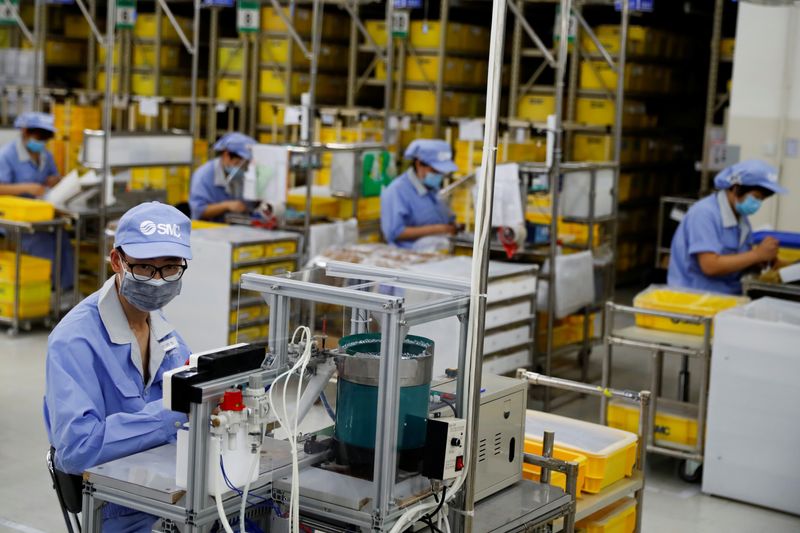China’s factory activity unexpectedly returns to growth in Sept
2022.09.29 22:52
[ad_1]

© Reuters. FILE PHOTO: Employees wearing face masks work at a factory of the component maker SMC during a government organised tour of its facility following the outbreak of the coronavirus disease (COVID-19), in Beijing, China May 13, 2020. REUTERS/Thomas Peter/Fil
BEIJING (Reuters) – China’s factory activity unexpectedly expanded in September, helped by a series of recent easing measures, but gains were marginal as the economy continued to grapple with strict COVID curbs, a deepening property crisis and softening exports growth.
Meanwhile, a sharp slowdown in services sector growth and a downbeat private manufacturing survey suggested the economy was struggling to regain traction after narrowly avoiding contraction in the second quarter.
The official manufacturing purchasing managers’ index (PMI) rose to 50.1 in September from 49.4 in August, the National Bureau of Statistics (NBS) said on Friday.
The gauge beat expectations for 49.6 in a Reuters poll of economists, and was above the 50-point mark that separates contraction from growth.
However, the private Caixin survey released on Friday showed factory activity contracted at a sharper pace in September, with indexes for output, new orders and employment all declining due to weak demand.
Growth in the services sector also slowed sharply, with the official non-manufacturing PMI falling to 50.6 in September from 52.6 in August. The official composite PMI, which includes manufacturing and services, fell to 50.9 from 51.7.
China’s government has rolled out more than 50 policy measures since late May, but repeated COVID lockdowns, a property crisis and a flagging export demand have weighed heavily on business and consumer confidence.
The official manufacturing PMI survey showed the new export orders index dropping to 47.0 from 48.1 in August. External demand has been hit by rising rates, high inflation and the war in Ukraine.
Stricter coronavirus measures in multiple cities including the tech hub of Shenzhen and mega city Chengdu contributed to falls in business confidence in the manufacturing sector.
With few signs China will significantly ease its zero-COVID policy soon, many analysts expect the economy to grow by just 3% this year. That would be the smallest growth since the 2.2% expansion in 2020, at the height of the COVID-19 pandemic, which was the slowest rate since 1976.
China’s economy generally recovered and stabilised in the third quarter, state media quoted Premier Li Keqiang as saying on Wednesday.
The government has vowed to push ahead with the implementation of policy support in the fourth quarter.
[ad_2]
Source link








